Long Live the People's Resistance against Aggression of
Globalization! Long Live the People's Occupation of
Nandigram!
Download this full report in PDF
[ As observed by Jiten Nandi, Shamik Sarkar, Md. Helaluddin, Subhapratim
Roychowdhury, Anupam Das Adhikari and Amita Nandi on behalf of Manthan Samayiki,
a bi-monthly Bengali little magazine from Kolkata, West Bengal.]
We, associated with a Bengali bi-monthly little magazine, 'Manthan Samayiki', went
Nandigram three times during January to March. Being the residents of Metiabruj in
Kolkata, we are neighbored by the people involved in garment industry, a communitybased
industry of muslim bengalees. Thousands of male villagers (about seventy-five
thousand, according to Morsalin Molla, MLA, Mahestala, South 24 Parganas) from
Nandigram block stay in Metiabruz and around temporarily for working in the
community garment industry. We went Nandigram each time along with these people.
We visited there on 18th January, 17-18 March and 27-29 March 2007. We travelled
within Nandigram by bicycles and van-rickshaw.
Nandigram is almost 160 km away from Kolkata. There are three blocks,
Nandigram I, II, and III in the district of East Medinipore. Nandigram I block is mostly
dominated by muslims and lower caste hindus. People survive by cultivation, fishing, and
engaging themselves in garment industry. Haldia township and industrial belt, being just
opposite to the Haldi river, promised them a huge opportunity of getting employment in
modern industries. But in reality, most of the workers who got jobs there, were driven off
once the construction works were finished. They realized that, in modern industries only
highly educated elites could manage a respectful job. Village people are going to get
nothing from there. Still now, some villagers go Haldia, for purely temporary contractual
jobs with miserably low salary. We heard about the Jellingham Project at Nandigram
Block 1, where about 400 acres of land had been acquired in 1977 for ship repairs. One
hundred and forty two families lost their land. The Project stopped functioning after five
years and the site today lies deserted.
Nandigram fought British colonial rule gloriously, almost occupied itself from British
Raj in 1942. It took part in the tebhaga movement afterwards, under the leadership of
legendary Communist Bhupal Panda. The indomitable spirit of the community ( the
chashi-samaj ) Nandigram was carried positively by the leadership of Communist Party
of India in tebhaga movement. Time and again, Nandigram village-folks dug trenches on
roads to fight the aliens. In 1982, a movement under the leadership of Bhupal Panda
originated in Nandigram with the demand for development (roads, sanitation, water
supply, electrification, etc.). Police fired on the agitation and killed a student, Sudipta
Tewari. Again, village-folks dug trenches in Nandigram to prevent police from entering
into the villages.
Before 29th December 2006
A rumour was there in Nandigram for more than a year that some of the mouzas or
villages and cultivation land might be acquired by the State Government for instituting an
industrial zone, Special Economic Zone (SEZ). A land acquisition row was already there
nearby for increasing the area of Kulpi port which would take lands from coastal area
belonging to mostly fisherfolks and farmers. A committee, dubbed as Krishak Uchchhed
Birodhi O Jonoswartho Roksha Committee (Committee Against Eviction Of Peasants
And To Save People's Interest) was formed during August 2006 by Socialist Unity Centre
of India (SUCI) along with Indian National Congress for propaganda work against forced
land acquisition. Another committee started to function in Nandigram and adjacent
Khejuri block, called Krisi Jami Raksha Committee (KJRC) (Committee To Save
Farmland). It is a state-wide initiative led by main parliamentary opposition party, called
Trinamul Congress, formed in the pretext of land acquisition row in Singur of district
Hooghly for a Tata Motor's manufacturing unit. Another initiative, called Gana Unnoyon
O Jana Odhikar Sangram Samity (GUJOSS) (Association For The Struggle Of Mass
Development And People's Right), comprised of Jamait I Ulema Hind and Communist
Party of India (Marxist-Leninist) (Santosh Rana faction), established in Bhangar of
district South 24 Parganas in the last quarter of 2006 to fight forcible eviction of peasants
there for setting up of an industrial zone, started working in Nandigram during November
2006. Meanwhile, State Government occupied and fenced ( kanta-bera ) Singur land
imposing section 144 of penal code of India despite protest and refusal to take
compensation for land from a large section of villagers. And Ministers and ruling
Communist Party of India (Marxist) leaders started talking publicly of setting up a huge
chemical hub in Nandigram under the Selim group of Indonesia. GUJOSS started setting
up some village committees comprising villagers cutting across the boundary of party
affiliation after conducting a survey in some villages in Nandigram which showed that
almost 99 percent villagers were ready to 'give their lives before leaving their
motherland'.
29th December 2006 to 3rd January 2007
A public meeting was held on behalf of ruling CPI(M) in Nandigram market on 29th
December 2006 where MP from Tamluk and East Medinipore district leader Lakshman
Seth urged farmers to pave the way of development and industrialization in Nandigram
by giving up their lands, both farmland and residential land, against compensation. He
also urged people to take the opposition at gunpoint, alleged the villagers. He gave a list
of the names of the villages ( mouzas ) those would be taken for the proposed chemical
hub, on behalf of Haldia Development Authority of which he is the chairperson. Later
that document was found in District Land
Reforms Office. Male-folk returned to their
villages hearing the news. A large number of
male-folks, predominantly muslims, who
worked in Metiabruz or elsewhere came to
their villages for Idujjoha on 1st January
2007. They also became agitated hearing the
news that their birth-place ( matribhumi ) is
going to be forcibly occupied by the
government. On 3rd January 2007 a
Governmental car entered into Nandigram
and went to Kalicharanpur gram panchayet
office. People gathered and fearing forcible
land acquisition drive, rushed towards that
panchayet office. Panchayet Prodhan Samiran Bibi and her husband CPI(M) leader
Rejjak told them that a UNICEF team had arrived here for a government project for
Nirmal Gram Prokolpo or Fresh Village Project. People marched back, but in their way
to Garchakraberia, they found some four police vans with armed police force arrived
there in Osmanchawk. The procession asked the police why they came. Police replied
with lathicharge and gunfire which left 4 persons wounded. People got furious and
chased the police van. One police van had been torched in Garchakraberia Bhuta More.
All the police personnel left rapidly. Traditionally the peasant community of Nandigram
is hostile to police administration. In 1902, villagers burnt a Daroga, called Raimohan in
Gumgarh village of Nandigram who was backing a mahajon (money lender) called
Gopal, and attacked Nandigram police station. Several villagers were hanged later for
that offence by the British rulers. This memory is still alive among villagers through
folklores and songs. One such song goes like "Ki khela khelili Gopal Nandigramer
bajare/ Khelar tape Gumgarh kanpe/ Raimon daroga pure more/ kharer gadar bhetore.
(Gopal, what a trick you played in Nandigram market./ The trick trembled Gumgarh,/
leading Raimohan daroga to be burnt in a heap of paddy-grass). Till the day, i.e. 3rd
January the agitation was mostly dominated by male-folk of the villages. After this
incident women-folk from both communities, Hindu and Muslim came out of their
homes. Within an hour (in the afternoon) all the village populace started digging the
roads in their villages for preventing police to enter into the villages. Within 12 hours,
people dug more than hundred places, cut small concrete bridges, blocked the roads with
tree-trunks, huge trees, boulders and bricks all through the villages proposed for
acquisition for the chemical hub SEZ. People occupied their own villages. It was a huge
show of people's power and uprising. Sumit Sinha, a member of CPI(ML) (Santosh Rana
faction) was present there at that time. He described the event like one when 'people's
knowledge and initiative surpass leaders' episteme and craft'. He said that he was
reluctant to believe the incidence in North Bengal when over 100 km rail-track was
Torched police van (on 3rd January) carrying a poster,
we will not leave motherland for industry
eliminated within a night by people during Khadya Andolan in 1950s. Now, seeing this
mass initiative he started believing the actuality of that incidence.
Upto 7th January 2007
From 4th January 2007 people urged for unification of three above-stated committees. On
5th January 2007 a meeting was held in Etimkhana (muslim orphan house) in Tarachand
Bar beside Nandigram market
involving all block or district level
leaders of political parties who were
involved in those three committees. A
unified committee, called Bhumi
Uchchhed Protirodh Committee
(BUPC) (Committee for Resistance to
Eviction from Homeland) was
established from the meeting and
resolution was taken that nobody would
hoist their own political flags within
Nandigram excluding the case when a
political party was organizing a meeting or march on
its own. On 6th January noon, a huge public meeting
was held in Bhuta More, Garchakraberia announcing the formation of BUPC.
Meanwhile, the agitation led by KJRC in Khejuri was brutally suppressed by State
administration and CPI(M) cadres there and all the agitating villagers were made silent or
'proponent of industrialization' at gunpoint. Nandigram and Khejuri are separated by a
50ft wide canal called Talpatti Khal. A bridge separates two newly made (2004-2005,
under Pradhan Mantri Gram Sadak Jojona or Prime Minister Village Road Project)
pakka roads or pitched roads, Nandigram's one connects Talpatti Khal to Basulichawk
(16.2 kms.) and Khejuri's one connects Talpatti Khal to Rasulpur. Historically,
Nandigram was attacked time and again by Portuguese armada (Harmad in colloquial
tongue) or Pirates and British invaders through Khejuri. Nandigram people used to resist
them. Nandigram was again attacked on the onset of 7th January 2007, from Khejuri, with
bombs and bullets. It was a foggy morning. Thousands of people from the adjacent
villages (Bhangabera, Sonachura, Gangra, Adhikaripara, Gokulnagar, Tekhali etc) started
thronging at Talpatti Khal bridge, to resist the invaders, the 'army of industrialization', the
'harmad bahini', the 'cadres of Lakshman Seth', carrying sticks, Da (bamboo cutting
knife), Banti (knife used for domestic vegetables cutting). Three persons died of bullets
during resistance, namely, Bharat Mandal, Sekh Selim and Biswajit Maiti (12 year old).
A landlord of Bhangabera, Shankar Samanta (His two storied fort-like residence, gardens
and ponds constitute at least 20 acres of land, leaving aside the farmland he owned.
Almost all of the other houses in Bhangabera are made of mud. This family was
traditionally with Indian National Congress, also his father Sudhangsu Samanta, but
turned into CPI(M) two decades ago) was allegedly showing the invaders the key persons
of the resistance for killing them, villagers alleged to us. People chased him, captured and
burnt alive. His mansion was ransacked and torched also. Invaders stopped shooting after
the sunset. Thousands of people decided to dig the pakka road to cut the link between
Barricades with tree-trunks and boulders
Talpatti Bridge and Nandigram. The 16.2 km long pitched road was ornamented with
several ditches, trenches, tree-trunks, boulders, bricks. The war began.
7th January to 14th March 2007
As the war situation unfolded, formation of village committees, the organization from
below, virtually stopped. Instead political leaders of BUPC started leading the whole
resistance. People already started night-vigil to resist the invaders. When they found any
intrusion in night, they started
chanting Shankha from
households and making call of
alert ( ajan ) from mosques.
Hearing this everybody used to
come out of their households
and marched towards the
Talpatti Khal, which was
started to be termed as border,
colloquially. In a war like
situation, people couldn't resist
the sophistically armed police and cadre
force without weapons. And so weapons
including guns started to come in the hands
of villagers through some heavyweight political leaders of parliamentary opposition.
Villagers reorganized the barricades and trenches on roads in a manner so that one
could move by walking, bicycle or even Ricksaw, but no car or speedy motorbykes could
move in or out. The ferry service connecting Nandigram and Haldia through Haldi River
was cut out by ruling CPI(M) cadres temporarily, Haldia town being a stronghold of
them. The supply of cash crop and labour from Nandigram to Haldia was halted. Haldia
market faced a huge price rise. Fearing unrest in Haldia, ferry service resumed after seven
days. But labourers from Nandigram were systematically manhandled in Haldia by
CPI(M) cadres. Especially Muslims were targeted. It is very special. CPI(M) is known
internationally as the strongest
critique of Gujarat communal
riot and Hindu fundamentalism.
Cadres belonging to that party in
Haldia, started provoking
muslim sentiment by targeting
them specifically. The
Nandigram-Metiabruz buses
were systematically searched by
CPI(M) cadres in Nandakumar,
some 40 km away from
Nandigram, and people
belonging to those villages
proposed for chemical hub SEZ
A trench on Prime Minister Village Road Project road, with
a black flag of BUPC
were got down from buses and were advised to go by walking as 'they were opposing
industrialization, they should not be allowed to go by buses'. These things were done by
CPI(M) cadres after a state level leader of CPI(M), Benoy Konar called for 'making the
villagers' lives a hell encircling them from three directions' before media. The three
directions were Nandakumar, Khejuri and Haldia. Meanwhile Chief Minister Buddhadeb
Bhattacharya said before media that the proposed chemical hub would not be set up at
Nandigram, if villagers didn't want it there. He also announced to tear apart the Haldia
Development Authority's notice, before media. But Lakshman Seth, the Tamluk MP and
Haldia's strongman, urged for setting up the SEZ in Nandigram. Nirupam Sen, state
industry minister, also said in that
way. No official notification was
issued any further.
The everyday life of
village-folks hampered in a big
way. Cultivation, schools and
food supply and external
communications were hampered.
People overcame those, just by
solidarity within community.
People even ate raw khesari
leaves and cereals during these two and a half months. Help came
in the form of rices and cereals from adjacent villages. Village
life, in a contrast to the city dwellings, can live on its own resources, crops from fields,
fishes from ponds, quoak doctors etc. People survived by the virtue of their own
resources, despite the barricades and trenches they organized to occupy their own
villages. No festivals or ceremonies had been held in those villages during this period, be
it marriage ceremony, or tajia of Muharram. A handful of strong CPI(M) followers from
those villages left voluntarily fearing atrocities, or been driven away in some cases. The
total number wouldn't cross 120, the villagers urged. All the rest of CPI(M) followers
took up the call of resistance to save their home land and livelihood. Some of them led
the resistance also. The martyr, Bharat Mandal was one of them. These villages were
dominated by CPI-CPI(M) followers traditionally. All the villages became united
showing huge communal amity. BUPC remained the only organization left there.
On the eve of 14th March 2007
After a state wide, two-month long campaign for industrialization, CPI(M) organized a
big mass meeting in Kolkata on 11th March under the banner of Krishak Sabha, the
party's peasant wing. The home secretary of the State Government, Prasad Ranjan Roy
ordered the administration to RE-OCCUPY the Nandigram villages on 14th March 2007.
BUPC organized a mass deputation at Nandigram police station on 13th March. The mass
deputation was thronged by women-folks in thousands. After a meeting in state assembly
between East Midnapore district leader of Trinamul Congress, MLA Subhendu Adhikari
and Chief Minister Buddhadev Bhattacharya, Subhendu assured the BUPC leadership
that police would come on 14th March to repair the trenched and barricaded roads only.
A trench by Talpatti bridge
Police would use tear gas or fire blank from guns at most, BUPC leadership perceived.
They urged the villagers to organize a peaceful demonstration of at least 10 thousand by
the side of the Talpatti bridge and send back all their weapons. In a way, one can say that
BUPC leadership disarmed the village-folks on 12th and 13th March, who were indulged
in a war with the invaders for saving their homeland and saving themselves from
eviction. Villagers followed BUPC leaders' advices.
On 14th March 2007
The villages by the Talpatti canal were mostly populated by hindu community. And the
heart of the resistance was Garchakraberia, a muslim dominated village, which is 10 km
away from the Talpatti Khal. The shankhadhwani by hindu women-folk started as early
as at 3 am on 14th March. Children and women gathered beside the Talpatti bridge at 3
am and started puja of Gouranga idol and Singhabahini, the community believes that the
goddess save their land and lives. Muslim women and children came a little late, at 4 am
and started reading from Koran Sharif. Thousands of villagers, mostly children and
women were present there by the dawn. No prominent leaders of BUPC were available at
the spot, but local village level leaders were there.
Police started the operation on 10 am. They fired tear gas and within some
minutes began firing. Armed CPI(M) cadres came along with the police. The cadres wore
police uniform for camouflage. State reoccupied Sonachura, Bhangabera, Adhikaripara,
Tekhali (3 km from the Talpatti bridge) with police, special combat force, sophisticated
weapons, and CPI(M) cadres. Within one hour wounded persons started to come to illprepared
Nandigram Hospital. By the evening, 60 people came with injuries, mostly with
bullet injuries in upper parts of the body. So the firing was intended to KILL the
protestors, not to disperse them. 14 deaths have been reported immediately by
government. Party flag entered into those villages of Nandigram after two and a half
months. The victory of state over the villagers was celebrated there, and the rest part of
the East Medinipore district by hoisting innumerable brand-new hammer-and-sickle
marked red flags. Meanwhile, a district wide 12 hour strike was issued at the afternoon of
14th March by CPI(M) trade union wing CITU, to prevent the miscreants from hampering
the process of reinstallation of administration in Nandigram, according to 'The Hindu', a
media source. Everywhere in the district, CPI(M) cadres took the streets with flags,
blocked roads, and prevented the parliamentary opposition leaders, the Governor and the
media from entering into Nandigram. The ambulances carrying seriously wounded to
Tamluk hospitals were also attacked. Reports of huge death and disappearance of body,
rape started coming from Nandigram. Sonachura, Bhangabera, Adhikaripara, Tekhali
were completely under the control of police and armed CPI(M) cadres by the night of 14th
of March.
After 14th March 2007
Under the direction of Kolkata High Court, CBI team arrived at Nandigram on 15th
March. Police and cadres in Sonachura village organized the villagers there at gunpoint
for leading a procession for re-occupation of Garchakraberia on 16th March. But their
attempt failed, as almost 50
thousand villagers from other
villages, led by BUPC, came to
sonachura on 16th March morning.
Cadres escaped the villages. Police
forces presented their begged for
lives. Red flags had been replaced
with a handful of black ones of
BUPC, and predominantly with tricoloured
Trinamul Congress flags.
After the red ones, entered the tri-coloured party flags. After severe protests in and
outside of West Bengal and condemnation of state sponsored mass killing of unarmed
villagers, facing opposition from ruling coalition partners of decades, Left Front
Government decided to withdraw the police force from Nandigram systematically, issued
a notice on behalf of East Medinipore district magistrate stating that no land acquisition
would be held in Nandigram. It was the second official notice related to Nandigram SEZ.
First one was issued on behalf of Haldia Development Authority at the end of December
2006 providing the list of mouzas to be acquired in Nandigram, as stated above.
The struggle of Nandigram is still continuing. Now the land grab fear is over. But
the anguish and grief of losing a number of their comrades remains. Villagers are asking
for the punishment of the murderers and rapists. We asked the female-folk about what
kind of help they needed. They urged us to join the struggles 'like them'. The CPI(M)
party cadres are still bursting bombs at night, from the side of Khejuri. BUPC asked most
of the 'driven out' or 'left out' of the villages for their CPI(M) affiliation to come back, but
urged for the arrests of a few of them who were involved in the violent attack and
massacre on 14th March.
The residents of 38 villages, mostly a peasant population, predominantly
poor and marginal, in Nandigram fought a severely uneven fight for last 3 months.
It was a genuine people's resistance against globalization in its present aggresive
form. Global capital is installing SEZs, neo-colonies in India. Almost 200 SEZs are
already working in our country. Gujarat, Haryana, Orissa, Maharashtra, Uttar
Pradesh, Jharkhand etc are prominent states in SEZ maps of India. All state
governments, be it Congress led or BJP led or else, are asking for SEZ and
advocating it for industrialization and development. The SEZ Act was planned
during BJP led NDA government, and implemented in 2005 by Congress led UPA
government. It was passed by parliament without even any debate. The countrywide
people's resistance sent the act under review and sanction of fresh SEZs was
stopped, in January, immediately after the people's uprise and occupation in
Nandigram. Village-folks are resisting the land grab and forced eviction almost
everywhere, at Kalinganagar-Jagatsinghapur in Orissa, at Raigarh in Maharashtra,
in Jharkhand, in Uttarpradesh etc. Nandigram was one among them. And it
emerged VICTORIOUS. Chemical hub SEZ in Nandigram died before its birth. It's
a successful local resistance, a people's resistance against globalization with a
broader and immediate implication.
सीपीएम की क्रांति
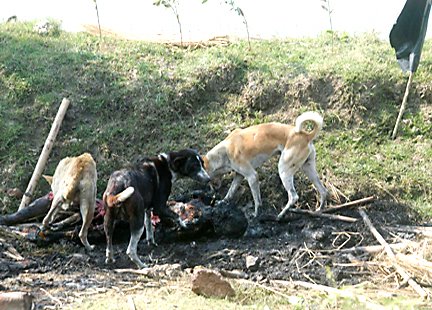
हम एक लोकतंत्र में रह रहे हैं! 14 मार्च को हुई घटना और उसके बाद सीपीएम के बंद के दौरान गायब हुए दो सौ लोगों का अब तक कोई अता-पता नहीं है्. हां। कुछ लाशें हैं जो इलाके में इस हालत में पायी गयी हैं. क्या हम बता सकते हैं कि इन्होंने किस बात की कीमत चुकायी? क्या हम इसको लेकर आश्वस्त रह सकते हं कि हमें भी कभी ऐसी ही कीमत नहीं चुकानी पड़ेगी?
Subscribe to:
Post Comments (Atom)
नंदीग्राम पर नयी फ़िल्म
यह फ़िल्म 14 मार्च की घटनाओं के सूक्ष्म विवरण के साथ आयी है.
देखें : नव उदारवाद का नया चेहरा बजरिये नंदीग्राम
देखें : विकास के नाम पर लोगों के उजड़ने की कहानी
उन्होंने मेरे पिता को टुकडों में काट डाला
देखें : न हन्यते
नंदीग्राम में 100 से ज्यादा लोग मारे गये हैं, 200 अब भी लापता हैं. वहां महिलाओं के साथ सीपीएम के कैडरों ने बलात्कार किया. बच्चों तक को नहीं छोड़ा गया है. सीपीएम की इस क्रूरता और निर्लज्जता का विरोध होना चाहिए. हमें नंदीग्राम, सिंगूर और हर उस जगह के किसानों के आंदोलन का समर्थन करना चाहिए, जो अपनी जमीन बचाने के लिए लड़ाई लड़ रहे हैं. यह दस्तावेज़ी फ़िल्म किसानों के इसी संघर्ष के बारे में है. यह फ़िल्म नंदीग्राम के ताज़ा नरसंहार से पहले बनायी गयी थी.
नंदीग्राम में जनसंहार के बाद के द्श्य
यह फिल्म पुलिस द्वारा नंदीग्राम में बर्बर तरीके से की गयी हत्याओं एवं उनकी भयावहता व बर्बरता के बारे में है. इसके कई दृ़श्य विचलित कर देनेवाले हैं.
नंदीग्राम प्रतिरोध्
नंदीग्राम में सरकारी आतंक
देखें : माकपा की गुंडागर्दी
नंदीग्राम में सीपीएम सरकार की पुलिस ने जो बर्बर कार्रवाई की, वह अब खुल कर सामने आने लगी है. यह फ़िल्म उसी बर्बरता के बारे में है. इसके कई दृश्य आपको विचलित कर सकते हैं. आप इसे तभी देखें जब आप वीभत्स दृश्य देख सकने की क्षमता रखते हों. हम खुद शर्मिंदा हैं कि हमें ऐसे दृश्य आपको दिखाने पड़ रहे हैं, पर ये आज की हकीकत हैं. इनसे कैसे मुंह मोडा़ जा सकता है?
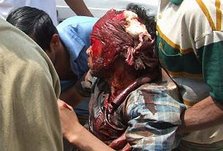
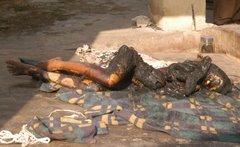
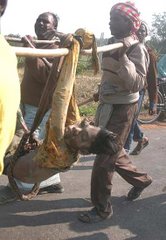
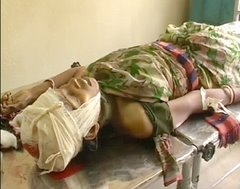

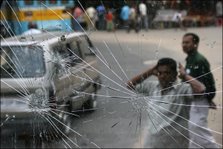
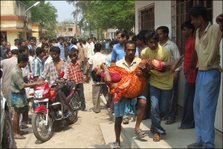

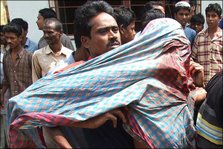


2 comments:
'MANTHAN SAMAYIKI' had done this work as a duty to know 'People's movement' and 'resistance'.
I read your detailed report on your magazine in Bengali , a lot of thanks will go to your account , how are they , the people of 'Nandigram' are doing now ? Can we get any recent update ?
Post a Comment